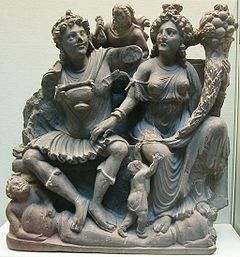
Pancika
Encyclopedia

Marriage
Marriage is a social union or legal contract between people that creates kinship. It is an institution in which interpersonal relationships, usually intimate and sexual, are acknowledged in a variety of ways, depending on the culture or subculture in which it is found...
of the Buddhist goddess of children, Hariti
Hariti
Hārītī , is a Gandharan ogeress and Bactrian mythological figure who was later transformed in to a symbol for the protection of children, easy delivery, happy child rearing and parenting, harmony between husband and wife, love, and the well-being and safety of the family...
. He is himself a Buddhist god, and is said to have fathered 500 children.
He was the commander-in-chief
Commander-in-Chief
A commander-in-chief is the commander of a nation's military forces or significant element of those forces. In the latter case, the force element may be defined as those forces within a particular region or those forces which are associated by function. As a practical term it refers to the military...
of the Yakṣa
Yaksha
Yaksha is the name of a broad class of nature-spirits, usually benevolent, who are caretakers of the natural treasures hidden in the earth and tree roots. They appear in Hindu, Jain and Buddhist mythology. The feminine form of the word is ' or Yakshini .In Hindu, Jain, and Buddhist mythology,...
army of Vaiśravaṇa
Vaisravana
' or ' also known as Jambhala in Tibet and Bishamonten in Japan is the name of the chief of the Four Heavenly Kings and an important figure in Buddhist mythology.-Names:...
(Bishamonten), and had another 27 Yakṣa generals under his orders.
Pañcika was often represented holding a lance
Lance
A Lance is a pole weapon or spear designed to be used by a mounted warrior. The lance is longer, stout and heavier than an infantry spear, and unsuited for throwing, or for rapid thrusting. Lances did not have tips designed to intentionally break off or bend, unlike many throwing weapons of the...
and a bag of jewels (or money), together with Hariti, in the Greco-Buddhist art
Greco-Buddhist art
Greco-Buddhist art is the artistic manifestation of Greco-Buddhism, a cultural syncretism between the Classical Greek culture and Buddhism, which developed over a period of close to 1000 years in Central Asia, between the conquests of Alexander the Great in the 4th century BCE, and the Islamic...
of Gandhara
Gandhara
Gandhāra , is the name of an ancient kingdom , located in northern Pakistan and eastern Afghanistan. Gandhara was located mainly in the vale of Peshawar, the Potohar plateau and on the Kabul River...
, where they illustrated marital love following the intervention of the Buddha
Gautama Buddha
Siddhārtha Gautama was a spiritual teacher from the Indian subcontinent, on whose teachings Buddhism was founded. In most Buddhist traditions, he is regarded as the Supreme Buddha Siddhārtha Gautama (Sanskrit: सिद्धार्थ गौतम; Pali: Siddhattha Gotama) was a spiritual teacher from the Indian...
. The two figures "were very popular in Gandhara in the latter part of the second century, and their statues are many." When depicted holding a spear, he also signals his role as the chief of the Yakṣas.
The Yakṣas are commanded by 28 generals, of whom the chief is Pañcika — according to the Mahavamsa
Mahavamsa
The Mahavamsa is a historical poem written in the Pali language, of the kings of Sri Lanka...
, he was the father of the 500 sons of Hariti [Kishimojin]. Possibly worshipped very early in Gandhara (some of his representations are found in other areas too where Gandharan influence is said to have spread. This general of the Yakṣas was soon merged with Vaiśravaṇa.

